There has been much excitement since Australia signed a landmark agreement with the United States last month to expand cooperation on critical minerals and rare earth elements.
Please login below to view content or subscribe now.
Membership Login

There has been much excitement since Australia signed a landmark agreement with the United States last month to expand cooperation on critical minerals and rare earth elements.
Please login below to view content or subscribe now.

Arizona State University has received a $50 million donation to launch the Global Institute for the Future of Energy, a collaboration between its Julie Ann Wrigley Global Futures Laboratory and the Thunderbird School of Global Management that seeks to promote education and innovation regarding energy production and use.
The gift comes from Bob Zorich, who earned his master’s degree in international management in 1974 from Thunderbird’s predecessor, the American Graduate School of International Management.
“ASU has long been a pioneer in building bold, pragmatic solutions for the future,” said Zorich, founder and managing partner of the Texas-based private equity firm EnCap Investments. “President Michael Crow has taken a visionary and action-oriented approach to positioning the university as a leading center for research, educational excellence and global influence. For these reasons, I was excited to fund the formation of this energy institute at ASU because of the university’s unique ability to scale and reach a global audience.”
Zorich’s gift will help the institute recruit a chair and staff and start developing curriculum for students, executives and the public. In the second year, the institute aims to launch a fellowship and executive-in-residence program, as well as a series of public programs, including lectures, summer camps and a global energy conference.
In addition, some of the funds will support Energy Switch, a point-counterpoint show on Arizona PBS that brings together experts from government, NGOs, academe and industry to debate energy-related topics.
“Energy is central to nearly every facet of our daily lives, and we have to prepare now for an evolving energy future,” Crow said in a statement. “With the rapid growth of AI and other fast-moving innovations, we have a responsibility to ready the next generation of energy leaders and solutions. Bob Zorich’s visionary investment will empower our global understanding of energy, our vital literacy and how we can work together to develop the best paths forward.”

The U.S. Department of Energy canceled plans to issue a rule that would have removed a regulatory requirement for colleges and schools receiving funding from the agency. The requirement in question is meant to level the playing field between women and men in athletics.
The Energy Department’s rule would have no longer required colleges and schools receiving Energy Department funding to provide women or girls a chance to try out for contactless men’s or boys’ sports teams in cases where no equivalent sports team exists for them.
Under current requirements, for example, girls must be allowed to try out for spots on the boys’ baseball team if there is no girls’ softball team.
In May, the Trump administration quietly proposed rescinding this requirement, along with a handful of other regulatory changes, by issuing a “direct final rule.” That process is usually reserved for uncontroversial regulations that are not expected to receive pushback, allowing an agency to issue new policies without incorporating changes based on public feedback.
On Sept. 10, however, the Energy Department said it was withdrawing the proposed change entirely after it received over 21,000 comments — many of them opposing the changes. The rescission came after the administration initially delayed the rule’s July 14 effective date until Sept. 12 amid significant pushback.
The withdrawal was celebrated by Title IX civil rights advocates, who worried the rule would reverse progress for girls and women in sports.
However, a handful of other changes remain — albeit delayed — on the Energy Department’s docket that would impact colleges and schools receiving the agency’s grants.
For example, the agency still plans to move forward with a rule that would no longer require colleges and schools to prevent systemic racial discrimination that may result from seemingly neutral policies.The Energy Department has twice delayed that proposal’s effective date as a result of pushback, most recently to Dec. 9.
“Withdrawing the athletics rule shows that public pressure works, but continuing forward with the other rules shows this administration is still determined to chip away at opportunities for women, girls, and communities of color,” said Shiwali Patel, senior director of safe and inclusive schools at the National Women’s Law Center, in a Sept. 9 statement. “Rescinding these other rules will deepen inequities in education and beyond.”
Patel and other education civil rights experts have expressed concern over the rules being issued through an expedited process.
The Energy Department did not comment in time for publication. However, it said in its notice of the proposal’s withdrawal that it is allowed to propose a rule in the future “that may be substantially identical or similar to those previously proposed.”
The administration’s decision to release the proposed rules through the Energy Department and attempt to push them through quickly marks a shift from typical K-12 policymaking, which is usually left to the U.S. Department of Education, some education experts said in July.
It could have been a trial run: Had the Energy Department’s proposals gone uncontested, it’s possible other agencies would have also tried setting education policy this way, they said.
“This is a paradigm shift on the part of how the federal government articulates and connects some of these tools to their education priorities,” Kenneth Wong, an education policy professor at Brown University, said in July, when the rules were originally set to take effect. “Basically every single school, in practically every single school district, has some grants from one of the many agencies in the federal government.”

The U.S. Department of Energy canceled plans to issue a rule that would have removed a regulatory requirement for schools receiving funding from the agency. The requirement in question is meant to level the playing field between boys and girls in athletics.
The Energy Department’s rule would have no longer required schools receiving Energy Department funding to provide girls a chance to try out for contactless boys’ sports teams in cases where no equivalent sports team exists for them. Under current requirements, for example, girls must be allowed to try out for spots on the boys’ baseball team if there is no girls’ softball team.
In May, the Trump administration quietly proposed rescinding this requirement, along with a handful of other regulatory changes, by issuing a “direct final rule.” That process is usually reserved for uncontroversial regulations that are not expected to receive pushback, allowing an agency to issue new policies without incorporating changes based on public feedback.
On Sept. 10, however, the Energy Department said it was withdrawing the proposed change entirely after it received over 21,000 comments — many of them opposing the changes. The rescission came after the administration initially delayed the rule’s July 14 effective date until Sept. 12 amid significant pushback.
The withdrawal was celebrated by Title IX civil rights advocates, who worried the rule would reverse progress for girls and women in sports.
However, a handful of other changes remain — albeit delayed — on the Energy Department’s docket that would impact schools receiving the agency’s grants.
For example, the agency still plans to move forward with a rule that would no longer require schools to prevent systemic racial discrimination that may result from seemingly neutral policies.The Energy Department has twice delayed that proposal’s effective date as a result of pushback, most recently to Dec. 9.
“Withdrawing the athletics rule shows that public pressure works, but continuing forward with the other rules shows this administration is still determined to chip away at opportunities for women, girls, and communities of color,” said Shiwali Patel, senior director of safe and inclusive schools at the National Women’s Law Center, in a Sept. 9 statement. “Rescinding these other rules will deepen inequities in education and beyond.”
Patel and other education civil rights experts have expressed concern over the rules being issued through an expedited process.
The Energy Department did not comment in time for publication. However, it said in its notice of the proposal’s withdrawal that it is allowed to propose a rule in the future “that may be substantially identical or similar to those previously proposed.”
The administration’s decision to release the proposed rules through the Energy Department and attempt to push them through quickly marks a shift from typical K-12 policymaking, which is usually left to the U.S. Department of Education, some education experts said in July.
It could have been a trial run: Had the Energy Department’s proposals gone uncontested, it’s possible other agencies would have also tried setting education policy this way, they said.
“This is a paradigm shift on the part of how the federal government articulates and connects some of these tools to their education priorities,” Kenneth Wong, an education policy professor at Brown University, said in July, when the rules were originally set to take effect. “Basically every single school, in practically every single school district, has some grants from one of the many agencies in the federal government.”

Tanish Doshi was in high school when he pushed the Tucson Unified School District to take on an ambitious plan to reduce its climate footprint. In Oct. 2024, the availability of federal tax credits encouraged the district to adopt the $900 million plan, which involves goals of achieving net-zero emissions and zero waste by 2040, along with adding a climate curriculum to schools.
Now, access to those funds is disappearing, leaving Tucson and other school systems across the country scrambling to find ways to cover the costs of clean energy projects.
The Arizona school district, which did not want to impose an economic burden on its low-income population by increasing bonds or taxes, had expected to rely in part on federal dollars provided by the Biden-era Inflation Reduction Act, Doshi said.
But under HR1, or the “one big, beautiful bill,” passed on July 4, Tucson schools will not be able to receive all of the expected federal funding in time for their upcoming clean energy projects. The law discontinues many clean energy tax credits, including those used by schools for solar power and electric vehicles, created under the IRA. When schools and other tax-exempt organizations receive these credits, they come in the form of a direct cash reimbursement.
At the same time, Tucson and thousands of districts across the country that were planning to develop solar and wind power projects are now forced to decide between accelerating them to try to meet HR1’s fast-approaching “commence construction” deadline of June 2026, finding other sources of funding or hitting pause on their plans. Tina Cook, energy project manager for Tucson schools, said the district might have to scale back some of its projects unless it could find local sources of funding.
“Phasing out the tax credits for wind and solar energy is going to make a huge, huge difference,” said Doshi, 18, now a first-year college student. “It ends a lot of investments in poor and minority communities. You really get rid of any notion of environmental justice that the IRA had advanced.”
The tax credits in the IRA, the largest legislative investment in climate projects in U.S. history, had marked a major opportunity for schools and colleges to reduce their impact on the environment. Educational institutions are significant contributors to climate change: K-12 school infrastructure, for example, releases at least 41 million metric tons of emissions per year, according to a paper from the Annenberg Institute at Brown University. The K-12 school system’s buses — some 480,000 — and meals also produce significant emissions and waste. Clean energy projects supported by the IRA were helping schools not only to limit their climate toll but also to save money on energy costs over the long term and improve student health, advocates said.
As a result, many students, consultants and sustainability leaders said, they have no plans to abandon clean energy projects. They said they want to keep working to cut emissions, even though that may be more difficult now.
Related: Become a lifelong learner. Subscribe to our free weekly newsletter featuring the most important stories in education.
Sara Ross, cofounder of UndauntedK12, which helps school districts green their operations, divided HR1’s fallout on schools into three categories: the good, the bad and the ugly.
On the bright side, she said, schools can still get up to 50 percent off for installing ground source heat pumps — those credits will continue — to more efficiently heat and cool schools. The network of pipes in a ground source pump cycles heat from the shallow earth into buildings.
In the “bad” category, any electric vehicle acquired after Sept. 30 of this year will not be eligible for tax credits — drastically accelerating the IRA’s phase-out timeline by seven years. That applies to electric school buses as well as other district-owned vehicles. Electric vehicle charging stations must be installed by June 30, 2026 at an eligible location to claim a tax credit.*
EPA’s Clean School Bus Program still exists for two more years and covers two-thirds of the funding for all electric school buses districts acquire in that time. The remaining one-third, however, was to be covered by federal and state tax credits.
The expiration of the federal tax credits could cost a district up to $40,000 more per vehicle, estimated Sue Gander, director of the Electric School Bus Initiative run by the nonprofit World Resources Institute.
Related: So much for saving the planet. Climate jobs, and many others, evaporate for 2025 grads
Solar projects will see the most “ugly” effects of HR1, Ross said.
Los Angeles Unified School District is planning to build 21 solar projects on roofs, carports and other structures, plus 13 electric vehicle charging sites, as part of an effort to reduce energy costs and achieve 100 percent renewable energy by 2040. The district anticipated receiving around $25 million in federal tax credits to help pay for the $90 million contract, said Christos Chrysiliou, chief eco-sustainability officer for the district. With the tight deadlines imposed by HR1, the district can no longer count on receiving that money.
“It’s disappointing,” Chrysiliou said. “It’s nice to be able to have that funding in place to meet the goals and objectives that we have.”

LAUSD is looking at a small portion of a $9 billion bond measure passed last year, as well as utility rebates, third-party financing and grants from the California Energy Commission, to help make up for some of the gaps in funding.
Many California State University campuses are in a similar position as they work to install solar to meet the system’s goal of carbon neutrality by 2045, said Lindsey Rowell, CSU’s chief energy, sustainability and transportation officer.
Tariffs on solar panel materials from overseas and the early sunsetting of tax credits mean that “the cost of these projects are becoming prohibitive for campuses,” Rowell said.
Sweeps of undocumented immigrants in California may also lead to labor shortages that could slow the pace of construction, Rowell added. “Limiting the labor force in any way is only going to result in an increased cost, so those changes are frightening as well,” she said.
New Treasury Department guidance, issued Aug. 15, made it much harder for projects to meet the threshold needed to qualify for the tax credits. Renewable energy projects previously qualified for credits once a developer spent 5 percent of a project’s cost. But the guidelines have been tightened — now, larger projects must pass a “physical work test,” meaning “significant physical labor has begun on a site,” before they can qualify for credits. With the construction commencement deadline looming next June, these will likely leave many projects ineligible for credits.
“The rules are new, complex [and] not widely understood,” Ross said. “We’re really concerned about schools’ ability to continue to do solar projects and be able to effectively navigate these new rules.”
Schools without “fancy legal teams” may struggle to understand how the new tax credit changes in HR1 will affect their finances and future projects, she added.
Some universities were just starting to understand how the IRA tax credits could help them fund projects. Lily Strehlow, campus sustainability coordinator at the University of Wisconsin, Eau-Claire, said the planning cycle for clean energy projects at the school can take ten years. The university is in the process of adding solar to the roof of a large science building, and depending on the date of completion, the project “might or might not” qualify for the credits, she said.
“At this point, everybody’s holding their breath,” said Rick Brown, founder of California-based TerraVerde Energy, a clean energy consultant to schools and agencies.
Brown said that none of his company’s projects are in a position where they’re not going to get done, but the company may end up seeing fewer new projects due to a higher cost of equipment.
Tim Carter, president of Second Nature, which supports climate work in education, added that colleges and universities are in a broader period of uncertainty, due to larger attacks from the Trump administration, and are not likely to make additional investments at this time: “We’re definitely in a wait and see.”
Related: A government website teachers rely on is in peril
For youth activists, the fallout from HR1 is “disheartening,” Doshi said.
Emma and Molly Weber, climate activists since eighth grade, said they are frustrated. The Colorado-based twins, who will start college this fall, helped secure the first “Green New Deal for Schools” resolution in the nation in the Boulder Valley School District. Its goals include working toward a goal of Zero Net Energy by 2050, making school buildings greener, creating pathways to green jobs and expanding climate change education.
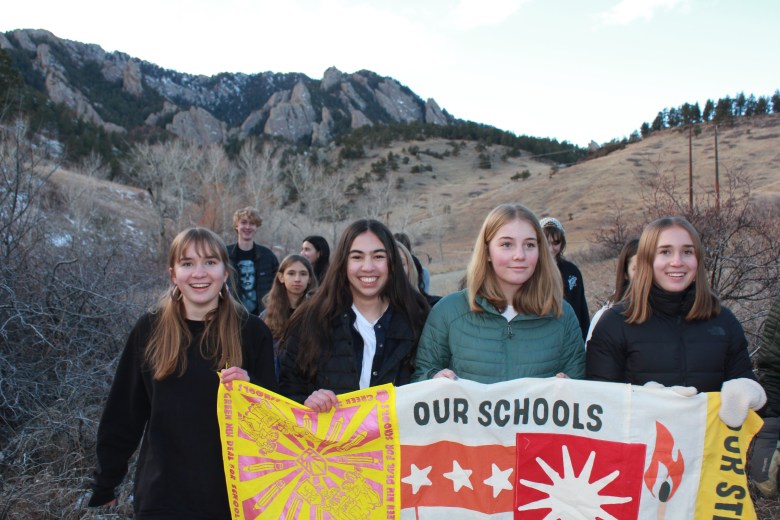
“It feels very demoralizing to see something you’ve been working so hard at get slashed back, especially since I’ve spoken to so many students from all over the country about these clean energy tax credits, being like, ‘These are the things that are available to you, and this is how you can help convince your school board to work on this,’” Emma Weber said.
The Webers started thinking about other creative ways to pay for the clean energy transition and have settled on advocating for state-level legislation in the form of a climate superfund, where major polluters in a community would be responsible for contributing dollars to sustainability initiatives.
Consultants and sustainability coordinators said that they don’t see the demand for renewable energy going away. “Solar is the cheapest form of energy. It makes sense to put it on every rooftop that we can. And that’s true with or without tax credits,” Strehlow said.
*Correction: This version of the story includes updated information on the timeline for the expiration of tax credits for electric vehicle charging stations.
Contact editor Caroline Preston at 212-870-8965, via Signal at CarolineP.83 or on email at [email protected].
This story about tax credits was produced by The Hechinger Report, a nonprofit, independent news organization focused on inequality and innovation in education. Sign up for the Hechinger newsletter.
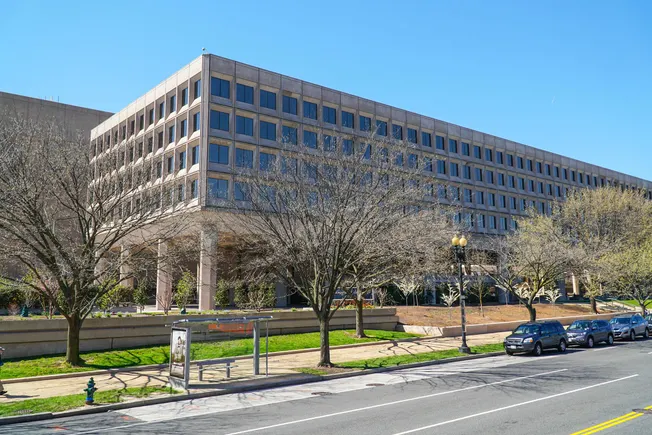
The U.S. Department of Energy delayed implementation of multiple rules that it had quietly set to go into effect this week for colleges and schools that receive funding from the agency. The move comes in response to public pushback to proposed policy changes.
The department said it was extending the effective dates for several direct final rules from July 15 to Sept. 12, 2025. The proposals would have undone some student protections related to sex discrimination under Title IX, disability discrimination under Section 504, and racial discrimination under Title VI.
One direct final rule, for example, would have no longer required schools to offer girls tryouts for boys’ teams in noncontact sports if the school didn’t have an equivalent girls’ team. Another would have removed protections allowing gender-conscious after-school programs or college initiatives to provide women and girls opportunities they have historically been denied, such as in STEM fields or in technical training.
Had the public not responded to the direct final rules with “significant adverse comments,” the rules would have undone such protections within a 30-day period — a much shorter timeline than the typical rulemaking process, which requires federal agencies to consider public feedback and make changes to their policy proposals accordingly.
The Trump administration’s decision to undo civil rights protections for students using expedited rulemaking — a process usually reserved for rules agencies expect to be uncontroversial — alarmed many civil rights organizations.
Kel O’Hara, senior attorney for policy and education equity at Equal Rights Advocate, called the move a “backdoor elimination of student protections.”
“The Trump Administration tried to exploit an obscure regulatory loophole meant only for minor administrative updates to gut fundamental protections for female athletes and transgender students,” O’Hara said in a Wednesday statement.
Typical rulemaking would require a public notice and comment period, and a second version of the rule that takes into consideration changes based on public feedback. That process also gives school districts more time to prepare for policy changes.
The rules were also atypical in that they were released by the Energy Department rather than the U.S. Department of Education — meaning only schools receiving Energy Department funding would have been impacted by this set of changes. The Energy Department gave 28 schools just over $160 million in fiscal year 2025, and provides over $2.5 billion annually to more than 300 colleges and universities to fund research.
However, had significant adverse comments not been received and delayed these rules’ implementation, and had the Energy Department been successful in its approach, the administration could have replicated the expedited method through other federal agencies to set education policies in many more schools, education policy experts predicted.
“This is a paradigm shift on the part of how the federal government articulates and connects some of these tools to their education priorities,” said Kenneth Wong, a professor of education policy at Brown University, when the direct final rules were announced. “Basically every single school, in practically every single school district, has some grants from one of the many agencies in the federal government.”
Most schools receive K-12 funding from multiple agencies, such as the Energy Department and the U.S. Department of Agriculture.
Because of the opposition to the rules, the Energy Department must now either withdraw them entirely or issue new final rules by September 12 that take the comments into account.
The Energy Department did not respond to a request for comment in time for publication.

The U.S. Department of Energy delayed implementation of multiple rules that it had quietly set to go into effect this week for schools that receive funding from the agency. The move comes in response to public pushback to proposed policy changes.
The department said it was extending the effective dates for several direct final rules from July 15 to Sept. 12, 2025. The proposals would have undone some student protections related to sex discrimination under Title IX, disability discrimination under Section 504, and racial discrimination under Title VI.
One direct final rule, for example, would have no longer required schools to offer girls tryouts for boys’ teams in noncontact sports if the school didn’t have an equivalent girls’ team. Another would have removed protections allowing gender-conscious after-school programs or college initiatives to provide women and girls opportunities they have historically been denied, such as in STEM fields or in technical training.
Had the public not responded to the direct final rules with “significant adverse comments,” the rules would have undone such protections within a 30-day period — a much shorter timeline than the typical rulemaking process, which requires federal agencies to consider public feedback and make changes to their policy proposals accordingly.
The Trump administration’s decision to undo civil rights protections for students using expedited rulemaking — a process usually reserved for rules agencies expect to be uncontroversial — alarmed many civil rights organizations.
Kel O’Hara, senior attorney for policy and education equity at Equal Rights Advocate, called the move a “backdoor elimination of student protections.”
“The Trump Administration tried to exploit an obscure regulatory loophole meant only for minor administrative updates to gut fundamental protections for female athletes and transgender students,” O’Hara said in a Wednesday statement.
Typical rulemaking would require a public notice and comment period, and a second version of the rule that takes into consideration changes based on public feedback. That process also gives school districts more time to prepare for policy changes.
The rules were also atypical in that they were released by the Energy Department rather than the U.S. Department of Education — meaning only schools receiving Energy Department funding would have been impacted by this set of changes. The Energy Department gave 28 schools just over $160 million in fiscal year 2025, and provides over $2.5 billion annually to more than 300 colleges and universities to fund research.
However, had significant adverse comments not been received and delayed these rules’ implementation, and had the Energy Department been successful in its approach, the administration could have replicated the expedited method through other federal agencies to set education policies in many more schools, education policy experts predicted.
“This is a paradigm shift on the part of how the federal government articulates and connects some of these tools to their education priorities,” said Kenneth Wong, a professor of education policy at Brown University, when the direct final rules were announced. “Basically every single school, in practically every single school district, has some grants from one of the many agencies in the federal government.”
Most schools receive K-12 funding from multiple agencies, such as the Energy Department and the U.S. Department of Agriculture.
Because of the opposition to the rules, the Energy Department must now either withdraw them entirely or issue new final rules by September 12 that take the comments into account.
The Energy Department did not respond to a request for comment in time for publication.
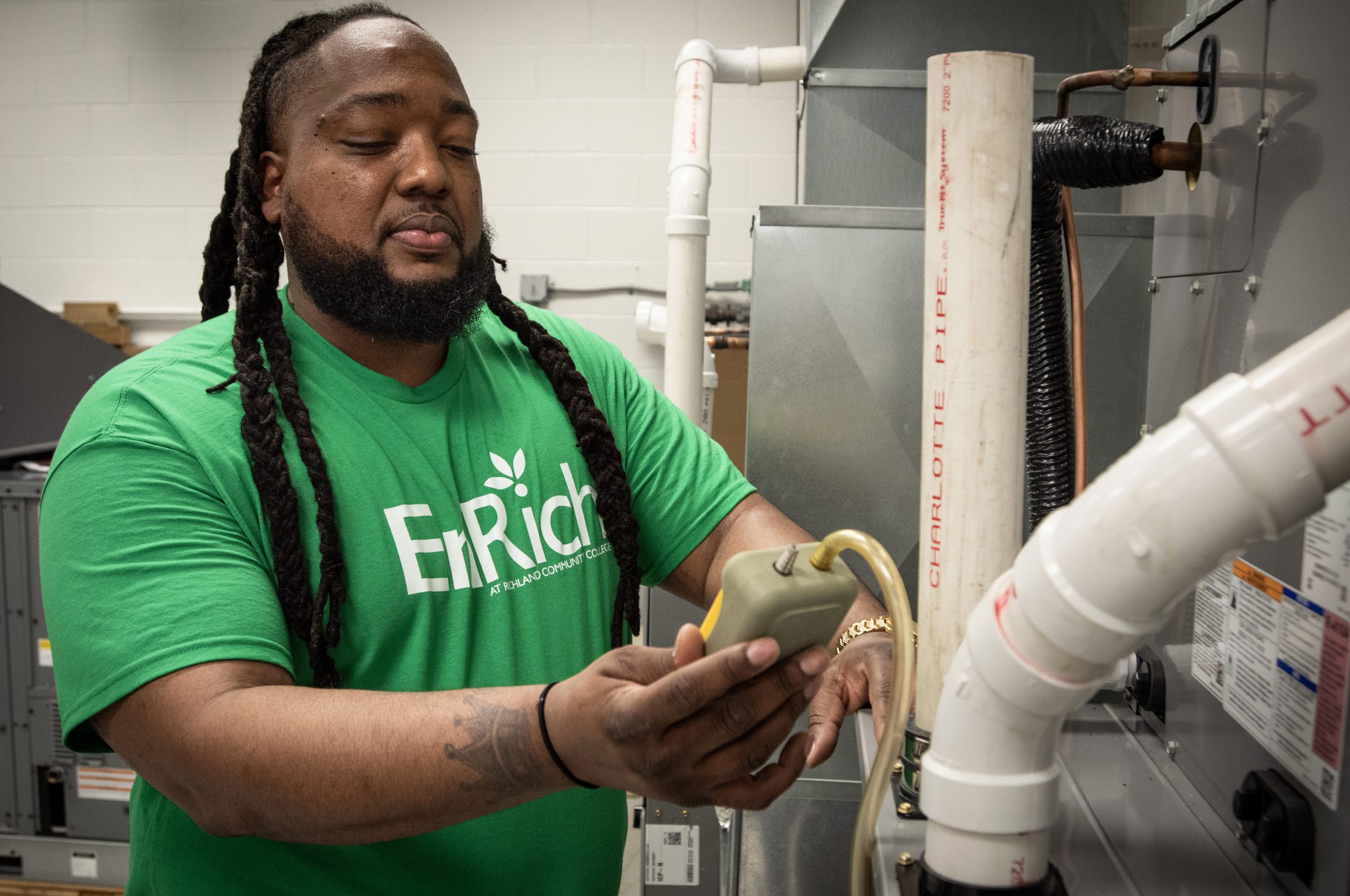
Decatur, Illinois, has been losing factory jobs for years. A training program at a local community college promises renewal and provides training for students from disenfranchised communities
This story is part of a collaboration between the Institute for Nonprofit News’ Rural News Network and Canary Media, South Dakota News Watch, Cardinal News, The Mendocino Voice and The Maine Monitor, with support from Ascendium Education Group. It is reprinted with permission.
DECATUR, IL. — A fistfight at a high school football game nearly defined Shawn Honorable’s life.
It was 1999 when he and a group of teen boys were expelled and faced criminal charges over the incident. The story of the “Decatur Seven” drew national headlines and protests led by the Rev. Jesse Jackson, who framed their harsh treatment as blatant racism. The governor eventually intervened, and the students were allowed to attend alternative schools.
Honorable, now 41, was encouraged by support “from around the world,” but he said the incident was traumatizing and he continued to struggle academically and socially. Over the years, he dabbled in illegal activity and was incarcerated, most recently after a 2017 conviction for accepting a large amount of marijuana sent through the mail.
Today, Honorable is ready to start a new chapter, having graduated with honors last week from a clean energy workforce training program at Richland Community College, located in the Central Illinois city of Decatur. He would eventually like to own or manage a solar company, but he has more immediate plans to start a solar-powered mobile hot dog stand. He’s already chosen the name: Buns on the Run.
“By me going back to school and doing this, it shows my nephews and my little cousins and nieces that it is good to have education,” Honorable said. “I know this is going to be the new way of life with solar panels. So I’ll have a step up on everyone. When it comes, I will already be aware of what’s going on with this clean energy thing.”
After decades of layoffs and factory closings, the community of Decatur is also looking to clean energy as a potential springboard.
Located amid soybean fields a three-hour drive from Chicago, the city was long known for its Caterpillar, Firestone Tire, and massive corn-syrup factories. Industrial jobs have been in decline for decades, though, and high rates of gun violence, child poverty, unemployment, and incarceration were among the reasons the city was named a clean energy workforce hub funded under Illinois’ 2021 Climate and Equitable Jobs Act (CEJA).
Decatur’s hub, based at Richland Community College, is arguably the most developed and successful of the dozen or so established statewide. That’s thanks in part to TCCI Manufacturing, a local, family-owned factory that makes electric vehicle compressors. TCCI is expanding its operations with a state-of-the-art testing facility and an on-site campus where Richland students will take classes adjacent to the manufacturing floor. The electric truck company Rivian also has a factory 50 miles away.
“The pieces are all coming together,” Kara Demirjian, senior vice president of TCCI Manufacturing, said by email. “What makes this region unique is that it’s not just about one company or one product line. It’s about building an entire clean energy ecosystem. The future of EV manufacturing leadership won’t just be on the coasts — it’s being built right here in the Midwest.”
Powering Rural Futures: Clean energy is creating new jobs in rural America, generating opportunities for people who install solar panels, build wind turbines, weatherize homes and more. This five-part series from the Rural News Network explores how industry, state governments and education systems are training this growing workforce.
Related: Want to read more about how climate change is shaping education? Subscribe to our free newsletter.
The Decatur CEJA program has also flourished because it was grafted onto a preexisting initiative, EnRich, that helps formerly incarcerated or otherwise disenfranchised people gain new skills and employment. The program is overseen by the Rev. Courtney Carson, a childhood friend of Honorable and another member of the Decatur Seven.
“So many of us suffer significantly from our unmet needs, our unhealed traumas,” said Carson, who was jailed as a young man for gun possession and later drag racing. With the help of mentors including Rev. Jackson and a college basketball coach, he parlayed his past into leadership, becoming associate pastor at a renowned church, leading a highway construction class at Richland, and in 2017 being elected to the same school board that had expelled him.
Carson, now vice president of external relations at the community college, tapped his own experience to shape EnRich as a trauma-informed approach, with wraparound services to help students overcome barriers — from lack of childcare to PTSD to a criminal record. Carson has faith that students can overcome such challenges to build more promising futures, like Decatur itself has done.
“We have all these new opportunities coming in, and there’s a lot of excitement in the city,” Carson said. “That’s magnificent. So what has to happen is these individuals who suffered from closures, they have to be reminded that there is hope.”
Richland Community College’s clean energy jobs training starts with an eight-week life skills course that has long been central to the larger EnRich program. The course uses a Circle of Courage practice inspired by Indigenous communities and helps students prepare to handle stressful workplace situations like being disrespected or even called a racial slur.
“Being called the N-word, couldn’t that make you want to fight somebody? But now you lose your job,” said Carson. “We really dive deep into what’s motivating their attitude and those traumas that have significantly impacted their body to make them respond to situations either the right way or the wrong way.”
The training addresses other dynamics that might be unfamiliar to some students — for example, some male students might not be prepared to be supervised by a woman, Carson noted, or others might not be comfortable with LGBTQ+ coworkers.
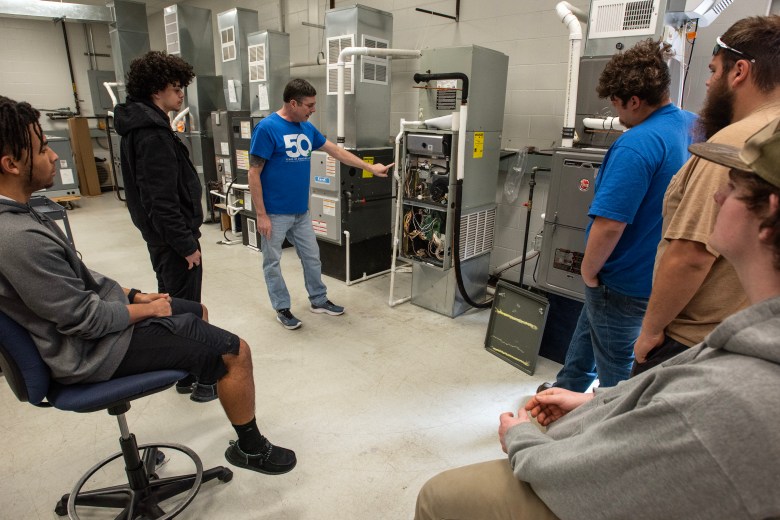
Life skills are followed by a construction math course crucial to many clean energy and other trades jobs. During a recent class, 24-year-old Brylan Hodges joked with the teacher while converting fractions to decimals and percentages on the whiteboard. He explained that he moved from St. Louis to Decatur in search of opportunity, and he hopes to become a property manager overseeing solar panel installation and energy-efficiency upgrades on buildings.
Students take an eight-hour primer in clean energy fields including electric vehicles, solar, HVAC, and home energy auditing. Then they choose a clean energy track to pursue, leading to professional certifications as well as a chance to continue at Richland for an associate degree. Under the state-funded program, students are paid for their time attending classes.
Marcus James was part of the first cohort to start the program last October, just days after his release from prison.
He was an 18-year-old living in Memphis, Tennessee, when someone shot at him, as he describes it, and he fired back, with fatal consequences. He was convicted of murder and spent 12 years behind bars. After his release he made his way to Decatur, looking for a safer place to raise his kids. Adjusting to life on the outside wasn’t easy, and he ended up back in prison for a year and a half on DUI and drug possession charges.
Following his release, he was determined to turn his life around.
“After I brought my kids up here, I end up going back to prison. But at that moment, I realized, man, I had to change,” James told a crowd at an event celebrating the clean jobs program in March.
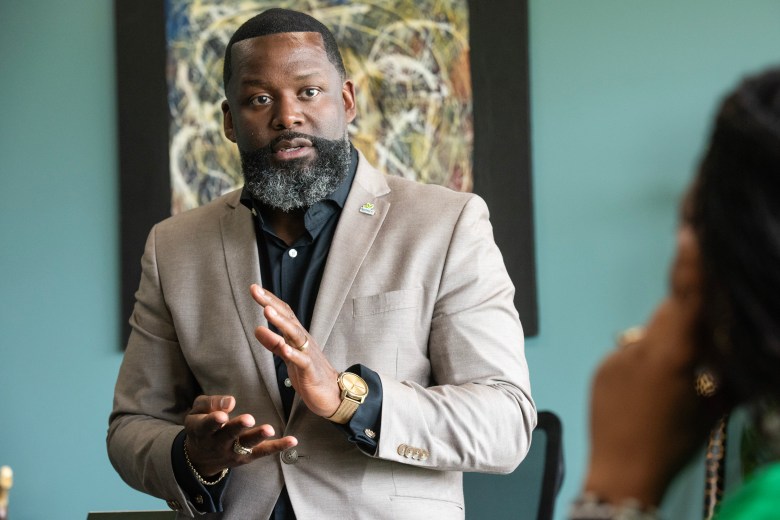
James said that at first, he showed up late to every class. But soon the lessons sank in, and he was never late again. He always paid attention when people talked, and he gained new confidence.
“As long as I put my mind to it, I can do it,” said James, who would like to work as a home energy auditor. Richland partners with the energy utility Ameren to place trainees in such positions.
“I like being out in the field, learning new stuff, dealing with homes, helping people,” James said, noting he made energy-efficiency improvements to his own home after the course.
Related: To fill ‘education deserts,’ more states want community colleges to offer bachelor’s degrees
Illinois’ 2017 Future Energy Jobs Act (FEJA) launched the state’s clean energy transition, baking in equity goals that prioritize opportunities for people who benefited least and were harmed most by the fossil fuel economy. It created programs to deploy solar arrays and provide job training in marginalized and environmental justice communities.
FEJA’s rollout was rocky. Funding for equity-focused solar installations went unspent while workforce programs struggled to recruit trainees and connect them with jobs. The pandemic didn’t help. The follow-up legislation, CEJA, expanded workforce training programs and remedied snafus in the original law.
Melissa Gombar is principal director of workforce development programs for Elevate, a Chicago-based national nonprofit organization that oversaw FEJA job training and subcontracts for a Chicago-area CEJA hub. Gombar said many community organizations tasked with running FEJA training programs were relatively small and grassroots, so they had to scramble to build new financial and human resources infrastructure.
“They have to have certain policies in place for hiring and procurement. The influx of grant money might have doubled their budget,” Gombar said. Meanwhile, the state employees tasked with helping the groups “are really talented and skilled, trying their best, but they’re overburdened because of the large lift.”
CEJA, by contrast, tapped community colleges like Richland, which already had robust infrastructure and staffing. CEJA also funds community organizations to serve as “navigators,” using the trust and credibility they’ve developed in communities to recruit trainees.
Richland Community College received $2.6 million from April 2024 through June 2025, and the Community Foundation of Macon County, the hub’s navigator, received $440,000 for the same time period. The other hubs similarly received between $1 million and $3.3 million for the past year, and state officials have said the same level of funding will be allocated for each of the next two years, according to the Illinois Clean Jobs Coalition.
CEJA hubs also include social service providers that connect trainees with wraparound support; businesses like TCCI that offer jobs; and affiliated entrepreneur incubators that help people start their own clean energy businesses. CEJA also funded apprenticeship and pre-apprenticeship programs with labor unions, which are often a prerequisite for employment in utility-scale solar and wind.
“The sum of the parts is greater than the whole,” said Drew Keiser, TCCI vice president of global human resources. “The navigator is saying, ‘Hey, I’ve connected with this portion of the population that’s been overlooked or underserved.’ OK, once you get them trained, send their resumes to me, and I’ll get them interviewed. We’re seeing a real pipeline into careers.”
The hub partners go to great lengths to aid students — for example, coordinating and often paying for transportation, childcare, or even car repairs.
“If you need some help, they always there for you,” James said.
Related: Losing faith: Rural, religious colleges are among the most endangered
In 1984, TCCI began making vehicle compressors in a Decatur plant formerly used to build Sherman tanks during World War II. A few decades later, the company began producing compressors for electric vehicles, which are much more elaborate and sensitive than those for internal combustion engines.
In August 2023, Gov. JB Pritzker joined TCCI President Richard Demirjian, the Decatur mayor, and college officials for the groundbreaking of an Electric Vehicle Innovation Hub, which will include a climatic research facility — basically a high-tech wind tunnel where companies and researchers from across the world can send EV chargers, batteries, compressors, and other components for testing in extreme temperatures, rain, and wind.
A $21.3 million capital grant and a $2.2 million electric vehicle incentive from the state are funding the wind tunnel and the new facilities where Richland classes will be held. In 2022, Pritzker announced these investments as furthering the state goal of 1 million EVs on the road by 2030.
Far from the gritty industrial environs that likely characterized Decatur workplaces of the past, the classrooms at TCCI feature colorful decor, comfortable armchairs, and bright, airy spaces adjacent to pristine high-tech manufacturing floors lined with machines.
“This hub is a game changer,” said Keiser, noting the need for trained tradespeople. “As a country, we place a lot of emphasis on kids going to college, and maybe we’ve kind of overlooked getting tangible skills in the hands of folks.”
A marketing firm founded by Kara Demirjian – Richard Demirjian’s sister – and located on-site with TCCI also received clean energy hub funds to promote the training program. This has been crucial to the hub’s success, according to Ariana Bennick, account executive at the firm, DCC Marketing. Its team has developed, tested, and deployed digital billboards, mailers, ads, Facebook events, and other approaches to attract trainees and business partners.
“Being a part of something here in Decatur that’s really leading the nation in this clean energy initiative is exciting,” Bennick said. “It can be done here in the middle of the cornfields. We want to show people a framework that they can take and scale in other places.”
With graduation behind him, Honorable is planning the types of hot dogs and sausages he’ll sell at Buns on the Run. He said Tamika Thomas, director of the CEJA program at Richland, has also encouraged him to consider teaching so he can share the clean energy skills he’s learned with others. The world seems wide open with possibilities.
“A little at a time — I’m going to focus on the tasks in front of me that I’m passionate about, and then see what’s next,” Honorable said. He invoked a favorite scene from the cartoon TV series “The Flintstones,” in which the characters’ leg power, rather than wheels and batteries, propelled vehicles: “Like Fred and Barney, I’ll be up and running.”

A federal judge temporarily blocked the U.S. Department of Energy’s plan to cap universities’ indirect research cost reimbursement rates, pending a hearing in the ongoing lawsuit filed by several higher education associations and universities.
Judge Allison D. Burroughs of the U.S. District Court for Massachusetts wrote in the brief Wednesday order that the plaintiffs had shown that, without a temporary restraining order, “they will sustain immediate and irreparable injury before there is an opportunity to hear from all parties.”
Plaintiffs include the Association of American Universities, the American Council on Education, the Association of Public and Land-grant Universities and nine individual universities, including Brown, Cornell and Princeton Universities and the Universities of Michigan, Illinois and Rochester. They sued the DOE and department secretary Chris Wright on Monday, three days after the DOE announced its plan.
Department spokespeople didn’t return Inside Higher Ed’s requests for comment Thursday afternoon.
DOE’s plan is to cap the reimbursement rates at 15 percent. Energy grant recipients at colleges and universities currently have an average 30 percent indirect cost rate. The Trump administration has alleged that indirect costs are wasteful spending, although they are extensively audited.
The DOE sends more than $2.5 billion a year to over 300 colleges and universities. Part of that money covers costs indirectly related to research that may support multiple grant-funded projects, including specialized nuclear-rated facilities, computer systems and administrative support costs.
The department’s plan is nearly identical to a plan the National Institutes of Health announced in February, which a judge also blocked.
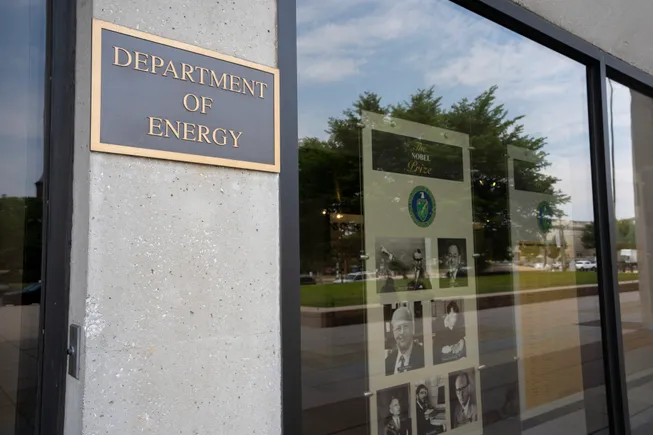
A federal judge Wednesday temporarily blocked the U.S. Department of Energy from implementing a 15% cap on grant funding for indirect costs. The ruling came just days after a dozen higher education associations and colleges sued the department, calling the new policy an overstep of authority and a threat to U.S. research and advancement.
In the ruling Wednesday, U.S. District Judge Allison Burroughs said the plaintiffs — including higher ed groups like the American Council on Education and threatened colleges like the University of Michigan and Brown University — had successfully demonstrated that they would “sustain immediate and irreparable injury” if the policy were allowed to proceed in tandem with the lawsuit.
Burroughs’ temporary restraining order bars the Energy Department — until further court order — from terminating grants, either under the challenged policy or “based on a grantee’s refusal to accept an indirect cost rate less than their negotiated rate.” The judge is also requiring the department to submit biweekly reports confirming that the federal funds are being distributed during the pause.
When announcing the funding cap last Friday, the Energy Department said the move would save $405 million annually and reduce what it called inefficient spending. Indirect research costs typically include overhead expenses such as facilities and administrative support staff.
The department said the change would affect over 300 colleges and that it would terminate grants to any institutions that failed to comply.
But the plaintiffs said the policy’s rapid implementation would give institutions no choice but to scale back funding and lay off staff.
Their lawsuit, filed in U.S. District Court in Massachusetts, called the Energy Department’s policy “a virtual carbon copy” of one announced in February by the National Institutes of Health. A federal judge permanently blocked NIH’s plan to cap indirect cost funding at 15% earlier this month, a decision the agency quickly appealed. The NIH plan would cost research universities billions in annual funding.
“DOE’s action is unlawful for most of the same reasons and, indeed, it is especially egregious because DOE has not even attempted to address many of the flaws the district court found with NIH’s unlawful policy,” the plaintiff’s lawsuit said.
The next hearing in the case is set for April 28 before the same court.